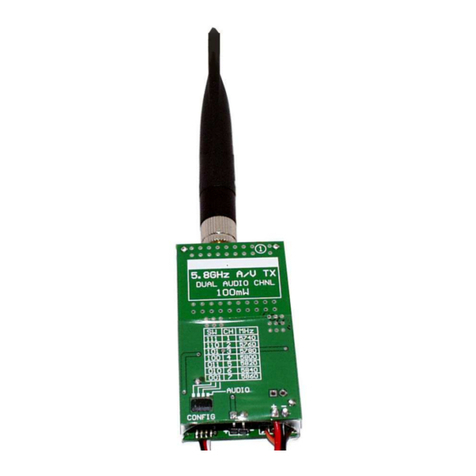
AV681TX-Kit, Rev C Page 1 © Nov-03-2008
AV681TX 5.8GHZ A/V TRANSMITTER KIT
Rev-C Hardware
INTRODUCTION
This 5.8Ghz 100mW A/V transmitter kit provides a custom printed circuit
board set and quality electronic components. All you need to add is an
antenna of your choice and about three hours of your time.
NOTICE: This kit involves precision SMD soldering and it is NOT intended for
beginners to assemble. It is suitable for amateur radio hobbyists and RF
technicians. The builder must have good quality soldering tools, an anti-static
work environment, and electronic assembly experience.
Note: This transmitter will require a ham radio license for hobby applications. Some
countries may prohibit use. Please consult your government’s spectrum regulations
before using this device.
BILL OF MATERIALS
QTY DESCRIPTION DESIGNATOR NOTES
==== =================== ============ =========================
3 .1uF Cap C1, C3, C8 0805 pkg.
4 47uF 6V Cap C6, C7, C20, C22 Observe polarity. 3528-21pkg.
1 47uF 16V Cap C21 Observe polarity. 6032-28 pkg.
3 330uF Cap C2, C4, C5 Observe polarity. 7343-31 pkg.
3 2.2K Resistor R1, R2, R3 0805 pkg.
1 22uH Inductor L1 3225 pkg.
1 DL4001 Diode D20 Observe polarity. MELF pkg.
2 KF50BDT U20, U21 TO-252 pkg.
1 DIP Switch S1 SOIC Package
1 SMA-RP Connector N/A Antenna connector
1 Tall Post Header, 4-pin PCB Assy Cut into one 2-pin and two 1-pin
1.75" Heatshrink, 2" Size N/A See text
1 Double-sided foam pad N/A See text
1 AWM681TX Module #AWM681TX Static sensitive, handle with care.
1 Printed Circuit Board Set PCB, Rev-C 2-piece PCB set
The following accessories are available separately. You may use our recommendations or any
suitable equivalent:
AVAILABLE ACCESSORIES
5.8GHz 8dBi Patch Antenna, #HG5808P-SMA and Coax Cable #CSR400 or #CSR316.
5.8GHz 5dBi Patch Antenna, #AWM5.8ANT
5.8GHz 4dBi Dipole Antenna, #ANTDRP-5.8.
5.8GHz 2dBi Dipole Antenna, #ANTTRP-5.8.
Tiny-Mic Amplified Microphone, #MIC-001


























